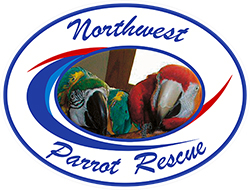Acclimation Process
Bonding
All newly rehomed parrots need time to get acquainted with their new environment and family. Some parrots have had a difficult past before transitioning into our sanctuary care or foster home.
These parrots may take a little bit longer to adjust to their new home when they are adopted. It is important for all new adopters to have their parrots recent and past bio-history records.
The Parrot Bio-form Questionnaire is a detailed log showing the history of their past home, recent foster home, a list of their diet, environment, activities, routine, likes, dislikes, and personality traits.
The following techniques have been refined and proven over more than thirty years of studying parrot behavior. This method will help you help your parrot have a much easier time adjusting to their new home.
Simple Three Step Acclimation Process
Step 1: Creating Trust and Bonding
The first 72 hours after your parrot’s arrival in its new home are crucial for creating trust and bonding with its primary care provider. This is a crucial step! Following these guidelines will ensure a smooth transition for you and your parrot.
- After your parrot’s arrival to his or her new home, keep the bird in its uncovered cage for a minimum of 48 hours.
- During this 72 hour period it is crucial that only the primary adopter is feeding, watering, or giving treats to your new parrot.
- The primary adopter should do most of the soft talking to your parrot during this bonding stage.
- The primary adopter should be the only one feeding the parrot for the minimum of its first 3 days.
- The first 24 hours during this transition period, it’s crucial that the parrot remain in its cage to become familiar with its new surroundings.
- Upon the parrots second day, then the primary adopter should be the only one to open the cage and *Let the parrot come out of its cage on its own.
- This may take some time for some parrots.* It’s also crucial that the home should be free from any distractions like other animals roaming around. At this time your home needs to be a calm environment free of any distractions or unexpected interruptions like cell phones, or loud music or a loud television.
- Then ask for the parrot to step up onto your hand after at least one minute of it being perched on their cage door.
- No one else should participate in caring for your parrot during this trust and bonding stage for three days.
- Allow the bird to discover and interact with its new adopter.
- Then the primary adopter should start the trust and bonding with that person, with a slow walk around the house. It’s important that the new adopter walk slowly and carefully around each corner so the parrot can discover its new home without any surprises. Do this carefully and the parrot will trust you quicker for allowing it to discover its new surroundings slowly.
- *Avoid a difficult transition by not allowing anyone break or interrupt you during this bonding procedure.*
Step 2: Bonding the Right Way
it’s important that the primary care provider should not show affection towards any other animal or human in front of the new parrot for a minimum of 3 days. *(if at all possible 30 days) It is especially important to avoid getting angry or disciplining any human or animal during the first 72 hours.
- Parrots are like 3 year-old children, with the intelligence of an 8 year old. During their first 3 to 30 days they will try to test you to see how much the can get away with. Please be aware and cautious during this adjustment period. Remember, you are training them, not them training you! You need to set the ground rules during this period.
- Avoid responding to your parrot when they make an annoying sound or loud cry. If you do, you have just named yourself that annoying sound or cry will become your name*.
- Try your best not to overreact when your parrot makes an unwanted sound, or mimics something unappreciated sound. He or she may misunderstand your attention as a reward. The parrot will make that sound or noise to get your attention to come to it.*
- In some cases, the parrot will make a repetitive sound until they gain your attention. If this happens, you might try ignoring them when you arrive home. It’s best to begin to giving them attention and affection after they have been quiet for a while. Reward them for being quite, by only letting them out of their cage when there quite for a minimum of their first 30 days.*This way your training them, and you’re not being trained.*
Step 3: Maintaining a Healthy Relationship
When you give your parrot special attention and affection, be in the habit of limiting your attention to regular increments of time like 10 or 15 minutes at a time at first. If your schedule changes your parrot won’t understand and the change. So, small periods of attention are recommended at first. Maximum times of cuddling should be no longer than 30 minutes.* If not, you may experience some behavioral problems if you change your life style 5 years down the road. Your new parrots’ amount of special attention time is crucial to avoid any separation anxiety problems in the future.
It’s important that you don’t break this acclimation process during the first week, If you do, we recommended that you start over at step one. If you experience any adjustment problems, please contact your NW Parrot Rescue representative or your assigned parrot behaviorists.
*The asterisks are present to show proven techniques that are proven training techniques used for over the past 30 years.
